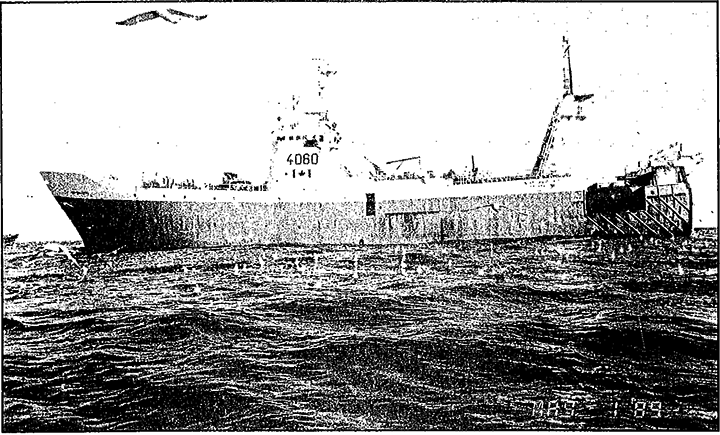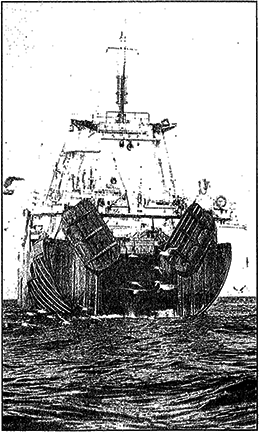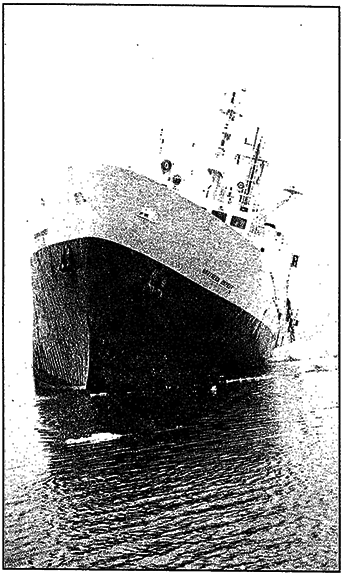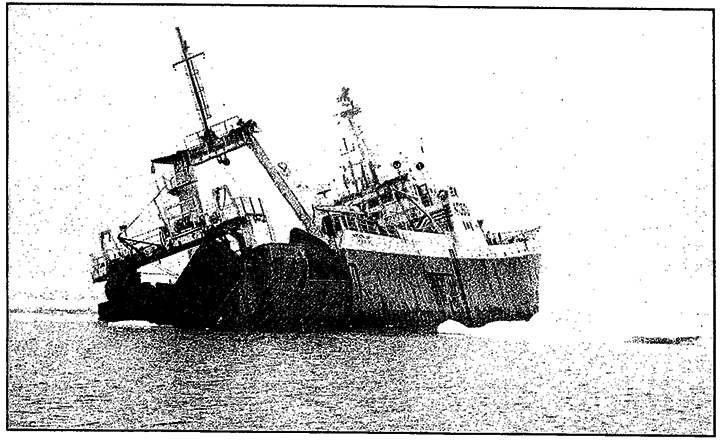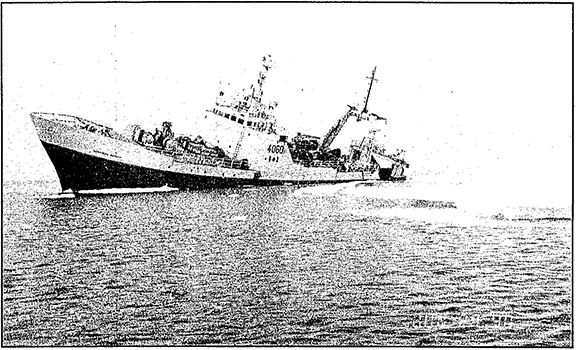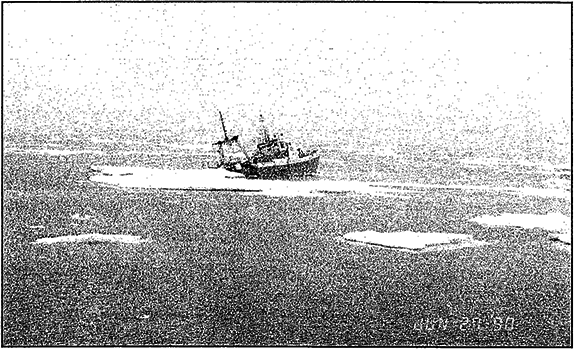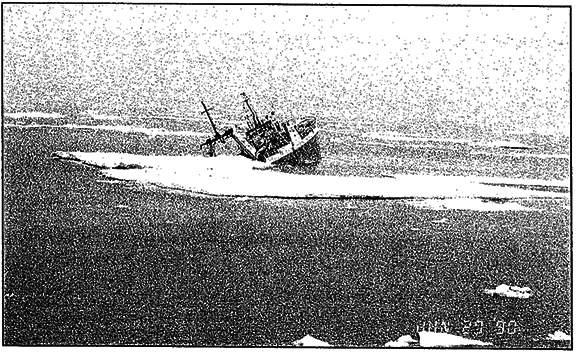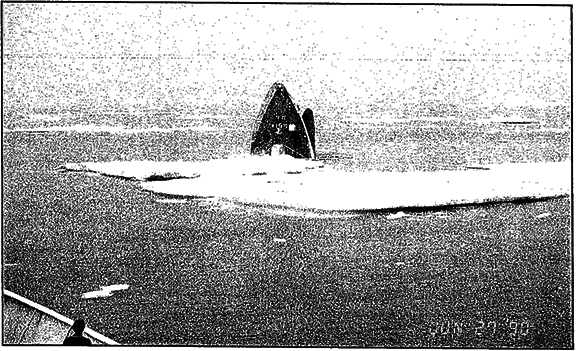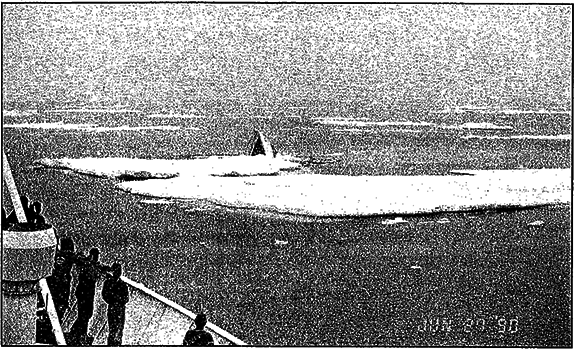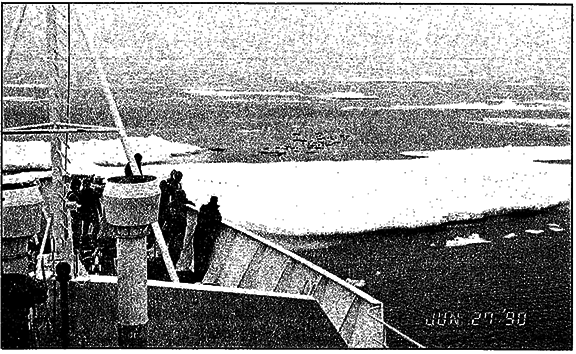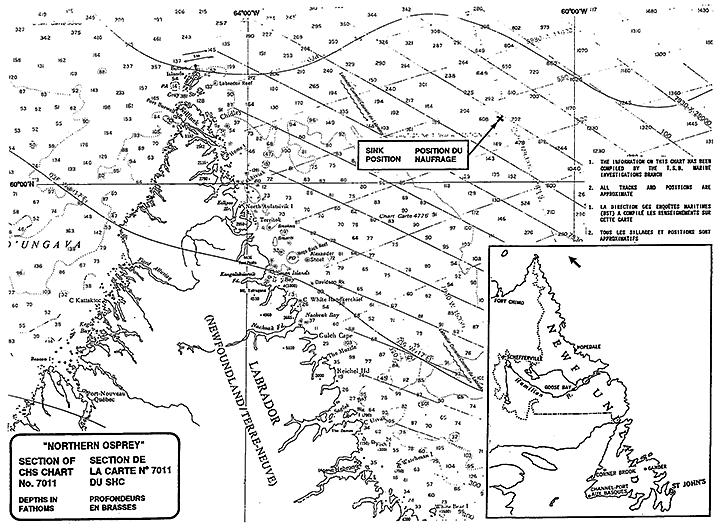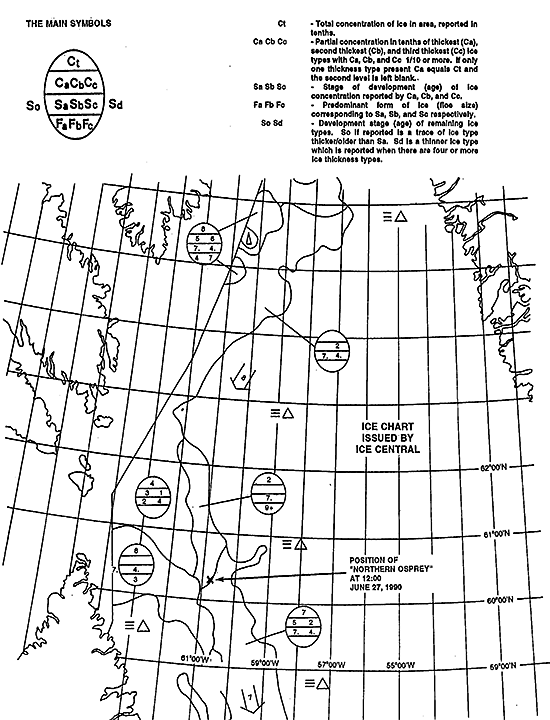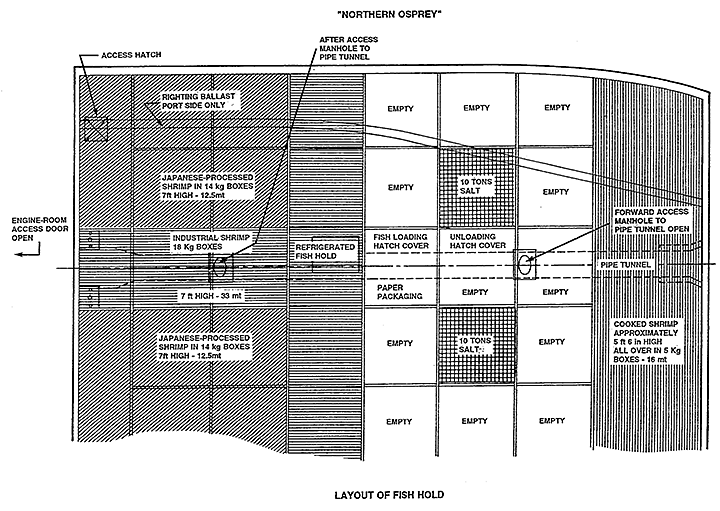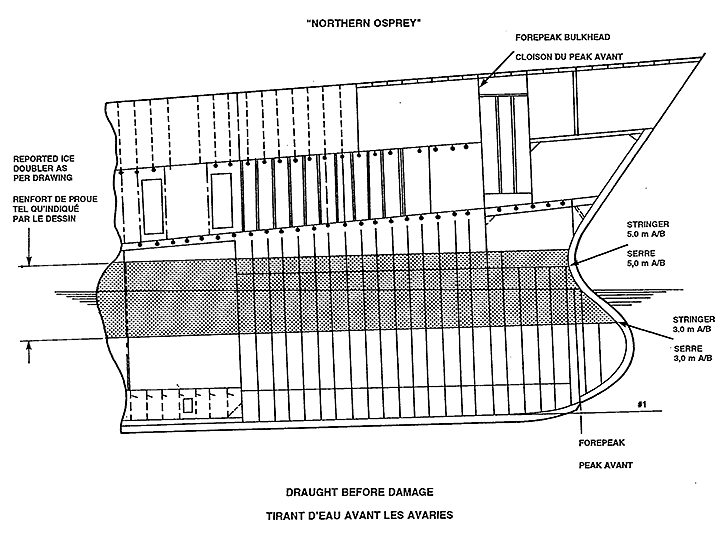F.V. "NORTHERN OSPREY" sank
in approximate position 60°23′N 60°54′W,
off Northern Labrador, as a result of being damaged by ice
The Transportation Safety Board of Canada (TSB) investigated this occurrence for the purpose of advancing transportation safety. It is not the function of the Board to assign fault or determine civil or criminal liability. This report is not created for use in the context of legal, disciplinary or other proceedings. See Ownership and use of content. Masculine pronouns and position titles may be used to signify all genders to comply with the Canadian Transportation Accident Investigation and Safety Board Act (S.C. 1989, c. 3).
Summary
The "NORTHERN OSPREY" had departed Mulgrave, Cape Breton, Nova Scotia, on 15 June 1990, bound for shrimp fishing grounds off eastern Labrador. (See Appendix A.)
While manoeuvring in ice-infested waters, on 27 June, the vessel sustained damage to her shell plating on the starboard bow in the vicinity of a common bulkhead between a fuel oil tank and the fish hold. As a result of this, fuel oil gained entry to the fish hold, followed some hours later by sea water.
The Transportation Safety Board of Canada determined that, while operating in ice conditions, it is most probable the vessel was holed, due to contact with ice. The holing was not detected and, in an effort to remove oil from the fish hold because it could not be effectively pumped, the watertight subdivision was lost when a manhole cover to the pipe tunnel and an access door from the pipe tunnel to the engine-room were removed/opened to drain the oil, and not replaced/closed. Sea water then flooded the hold and engine-room, and the vessel was lost.
Factual information
1.1 Particulars of the vessel
| Port of Registry | Halifax, Nova Scotia |
|---|---|
| Official number | 805168 |
| Call sign | VOKF |
| Type | Stern trawler (refrigerated) |
| Gross tonnage | 1,679 |
| Net tonnage | 775 |
| Length (LBP) | 54.51 m |
| Breadth moulded | 12.50 m |
| Depth Moulded | 8.01 m |
| Built | 1974, Scott & Sons (Bowling) 1969 Ltd. |
| Propulsion | Six-cylinder, Mirrlees Blackstone (Stockport) Ltd., 2,339 kW (3,180 BHP) |
| Owner | M.V. Osprey Ltd., Mulgrave (Nouvelle Ecosse) |
| Complement | 26 |
| Cargo | 74 tonnes of frozen shrimp |
| Draughts (approx. at time of casualty) | 5.5 m F 6.4 m A |
Navigation equipment
| Radar (1) | Furuno 10 cm FR 1226 (S-Band) |
|---|---|
| Radar (2) | Furuno 3 cm (colour) FCR 1411 (X-Band) |
| Both radars connected to a video plotter CD 2000 | |
| Loran C (1) | Furuno LC 80 |
| Loran C (2) | Furuno LC 80 |
| Sat. Nav. (1) | Furuno FSN 50 |
| Sat. Nav. (2) | Koden GT KG 900 GPS |
| Gyro Compass | Reflecting type |
| Magnetic Compass | Reflecting type |
| Echo Sounder (1) | FCR 121) to interchangeable |
| Echo Sounder (2) | FCR 111) transponder |
| Speed Log | Galatee 400 |
| Auto Pilot | Decca 450 |
Radio equipment
| VHF Radio (1) | Sailor RT 2047 |
|---|---|
| VHF Radio (2) | Robertson 800 |
| VHF Radio (3) | Spilsbury FMS 955 |
| SSB Radio (1) | Scanti TRP 5000 |
| SSB Radio (2) | Sailor 2000 B |
| Sat. Com. (telex, telefax and telephone) | Raytheon JUE 45E |
| Weather/Ice Facsimile | Furuno 108 |
| Lifeboat Radio | Scanti Marinetta |
Emergency position indicating radio beacon (EPIRB)
| EPIRB (1) | Koden 406 (above wheel-house) |
|---|---|
| EPIRB (2) | Koden 406 (portable) |
| EPIRB (3) | Koden 406 (portable) |
The "NORTHERN OSPREY" was a conventional stern freezer trawler of all-steel, welded construction. The navigating bridge and crew accommodations were forward of midships and, on each side of the stern ramp, were housed processing and refrigerating machinery.
1.2 History of the Voyage
At approximately 2200Footnote 1, 15 June, the "NORTHERN OSPREY" sailed from Mulgrave, Cape Breton, Nova Scotia, bound for shrimp fishing grounds off Labrador. The vessel had on board a crew of 23 men, and an additional three persons, a Canadian Fisheries Observer and two Japanese technicians representing the buyer of the catch.
En route to the first fishing area (Cartwright Channel), scattered ice was encountered on the evening of 17 June, at which time speed was reduced from normal sea speed of approximately 12 knots to 4 to 5 knotsFootnote 2. The logbook contains an entry for that date, "some very bad pieces" (of ice). Between 18 June, when fishing commenced in approximate position 50°51.2′N, 56°02′W, in 377 mFootnote 3 (206 fathoms) of water, until approximately 1330, 25 June, fishing continued in various weather and ice conditions, from calm seas and good visibility to strong breezes, rough seas with reduced visibility in rain and fog. Heading towards the fishing area "2" on the afternoon of 25 June, the vessel cleared an area of pack ice, and resumed full speed apparently without having sustained damage.
Until 27 June, the vessel was navigated through various ice conditions at various speeds, including areas of open water from which icebergs and bergy bits were observed, to areas in which ice coverage was 10 to 20 per cent, comprising floes of various sizes and composition including multi-year ice.
At approximately 0230, 27 June, while the vessel was proceeding at reduced speed stated to be some three knots, in position 60°30′N, 51°17.2′W, and the crew was preparing the trawling gear, diesel oil was reported in the fish hold, and the vessel developed a port list.
Shortly thereafter, the vessel was stopped and the master, at approximately 0500, from a dinghy, inspected the hull, without finding evidence of ice damage. The proximity of ice did not hinder the search for underwater damage and, although the sky was overcast, there was sufficient daylight as to render the use of artificial light unnecessary. No times were recorded for many of the events between the time of initial discovery of leakage being noticed and the abandonment of the vessel due to the master and his officers being more concerned with trying to save the vessel, the cargo and safety of the crew.
The fish hold bilge pumping system was unable to remove the diesel oil, which flooded the fish hold to a depth of approximately 0.5 m at the pipe tunnel manhole cover, however, it was deeper towards the port side aft. The manhole cover between the fish hold and the pipe tunnel was removed and the access door from the engine-room to the pipe tunnel was opened to allow oil accumulated in the fish hold to drain into the engine-room via the pipe tunnel, from where the oil was pumped overboard.
Concurrent with these activities, the vessel was put on easterly courses at reduced speed at about 0800, in an endeavour to once again reach open water. Other fishing vessels in the area were advised of the situation on board the "NORTHERN OSPREY" by VHF radio-telephone, on a ′Working frequency', channel 74. No call was made from the vessel to any Canadian Coast Guard Radio Station (CCGRS) on channel 16 VHF or 2182 MHz SSB (calling and distress frequencies). The Arctic Canada Traffic Zone (NORDREG) was not advised of the deliberate pumping of diesel oil into the sea.
Of other fishing vessels in the area and within a 20 to 30 mile radius, the closest were the Canadian-registered "NEWFOUNDLAND LYNX" and the "THOR TRAWL", both of which responded to the call for assistance. At approximately 0900, the main engine alarms sounded as the "engine-room (was) filling up rapidly".
The main engine was stopped, electrical power was lost and the engine-room and fish hold were filling with water. Shortly thereafter, the crew and supernumeraries were assembled on deck with their immersion suits and lifejackets. The vessel's four, 20-person capacity, inflatable liferafts were launched and inflated alongside, together with the dinghy (an inflatable rubber boat with an outboard engine).
At approximately 1015, when weather conditions were "heavy fog with 10 to 20 per cent ice coverage", the master ordered the "NORTHERN OSPREY" abandoned, and the crew, wearing immersion suits, boarded liferafts and the dinghy without incident. At approximately 1115, all hands were rescued by the "THOR TRAWL", and from that vessel, saw their own vessel sink, stern first, at 1200, in position 60°23.1′N, 60°54′W.
The "THOR TRAWL" salvaged the four liferafts, the rubber dinghy and the three EPIRBs (which had been removed from the stricken vessel) and waited, picking up pieces of floating debris and generally cleaning up the area until 1700, when she departed for Saglek, Labrador. From there, the survivors were transported by air the following day to their homes. At approximately 1200, CCGRS Labrador was informed of the loss of the "NORTHERN OSPREY" but no assistance from Search and Rescue was requested or required.
Sinking of the "NORTHERN OSPREY"
1.3 Injuries to Persons
| Crew | Passengers | Others | Total | |
|---|---|---|---|---|
| Fatal | - | - | - | - |
| Missing | - | - | - | - |
| Serious | - | - | - | - |
| Minor/None | 23 | - | 3 | 26 |
| Total | 23 | - | 3 | 26 |
The chief engineer suffered a certain amount of discomfort and temporary skin irritation as a result of working in about 0.5 m of diesel oil in the partly flooded fish hold while releasing a manhole cover. No water ingress to any compartment had been observed when this manhole cover was removed.
1.4 Vessel Certification
The vessel's certificates (or copies) were examined and found to be in order. An Arctic Shipping Pollution Prevention Certificate and an Arctic Waters Pollution Prevention Certificate were neither requested nor required as the vessel was not operating within the zones as defined in these regulations, although when she sank she was at or near the eastern limit of zone 15; i.e., 100 miles offshore. The "NORTHERN OSPREY" was last inspected by a steamship inspector of the Canadian Coast Guard (CCG) on 6 March 1990, indicating that the vessel was deemed to be fit for the proposed voyage. The certificate (SIC 31), issued to the "NORTHERN OSPREY", was due to expire 11 February 1991.
With a crew of 23 men, including the master, there was a sufficient number of crew and certificated officers to comply with the safe operation of the vessel, as required by the Manning and Deck Watch Regulations.
1.5 Fish Hold Bilge
At the time of construction and at the request of the then owners, the vessel was built in accordance with the Lloyd's Register of Shipping Rules and Regulations for the Construction and Classification of Steel Ships, 1974, and was issued the +100A1 and the +LMC class notations. As there was no RMC class notation assigned to the "NORTHERN OSPREY", the vessel's reefer plant and installations were neither required to be inspected nor were the plans approved, or required to be approved, by the Classification Society. The "NORTHERN OSPREY" was retained and in class at the time of the occurrence. While in class, the vessel was subjected to periodic hull and machinery examination including the bilge pumping system. During the required 1990 Annual Survey of the main bilge pumping system, the vessel had been required to demonstrate that the system to all compartments was functioning satisfactorily. Although not required by Rules, the fish hold compartment bilge pumping system was also checked for satisfactory operation at the time of Annual Survey.
If the reefer plant had been classed (RMC), the provisions in the Refrigerated Cargo Installation Rules (Part 4 Chapter 3 Para 4.5 of the 1989 edition which are similar in content to the 1974 edition) for the drainage of cargo spaces would have been formally addressed. These Rules and Regulations for drainage are as follows:
4.5 Drainage from refrigerated cargo spaces
4.5.1 Provision is to be made for the continuous drainage of the inside of all insulated chambers and cooler trays.
4.5.2 Drains which are led from lower holds and cooler trays situated on the tank top are to be fitted with liquid sealed non-return bilge traps.
4.5.3 Drains from 'tween deck chambers and from cooler trays which are situated well above the tank top are also to be fitted with liquid sealed traps, but the non-return valves may be omitted if desired.
4.5.4 Where drains from separate chambers join a common main, the branch pipes are each to be provided with a liquid sealed trap.
4.5.5 The liquid sealed traps are to be of adequate depth, and arrangements are to be made for ready access to the traps for cleaning and refilling with brine.
4.5.6 Sluices, scuppers or drain pipes which would permit drainage from compartments outside the insulated chambers into the bilges of the latter, are not to be fitted.
4.5.7 Screwed plugs or other means for blanking off scuppers draining insulating chambers and cooler trays are not to be fitted. If, however, it is specially desired to provide means for temporarily closing these scuppers, they may be fitted with shut-off valves controlled from readily accessible positions on a deck above the load waterline.
At the time that the vessel was transferred to Canadian registry in 1985, the Large Fishing Vessel Inspection Regulations, in the section Bilge Pumping and Piping, was applicable; no specification is made concerning fish hold bilges, refrigerated or non-refrigerated.
The fish hold bilge system was a means of removing a relatively small amount of water from that compartment and can be considered in a damage control mode only to the extent of its capability of removing 1,052 litres/minute maximum in non-freezing conditions.
The system was approved under the Large Fishing Inspection Regulations by the CCG, Ship Safety Branch, when the vessel was transferred to Canadian registry.
1.6 Qualifications and Experience/Master and Officers
The master possesses a Canadian-issued Fishing Vessel Master's Certificate, had attended a Marine Emergency Duties (MED) III course and had been in command of this and other vessels for approximately 20 years. His adult life had been spent on board fishing and seal hunting vessels, mainly as mate and master. He had spent about six months each year navigating in Canadian east coast arctic ice during which period some of the vessels had sustained damage and one was lost due to ice damage.
The mate possesses a Canadian-issued Fishing Vessel Master's Certificate (Class III) and had served on this vessel as mate for approximately 3 1/2 years. He has served as boatswain and deck-hand for 12 years, including many years of fishing in the northern waters of the Arctic and Greenland.
The chief engineer who possesses a Canadian-issued Certificate of Competency as chief engineer for use on motor-driven fishing vessels had served on this vessel for approximately 3 1/2 years in the capacity of chief engineer and on other vessels in various engineering capacities for a total of approximately 14 years.
1.7 Meteorological Information
A low pressure area of 1,004 millibars (mb), centered near and to the south of the position in which the "NORTHERN OSPREY" sank, produced light variable winds of less than 20 knots, cloudy and overcast skies with visibility reduced in fog and showers. The air temperature was approximately -1oC and the sea water temperature was at or slightly below 0oC. Due to the proximity of ice, seas were calmer than usually produced with winds of 20 knots.
1.8 Ice Conditions (See Appendix B.)
The ice conditions in which the "NORTHERN OSPREY" was operating before sinking were compatible with the ice forecasts and were such that approximately two tenths of the sea surface was covered in floes of old ice with high concentrations of strips of multi-year ice. The master reported ice of about one metre above the surface, and ice conditions nearby had been reported of thicknesses exceeding 140 cm (55 inches). Based on the master's estimate of the ice thickness above the surface, it could have extended to as much as nine metres beneath the surface.
Every spring, off the coast of Labrador and Newfoundland, ice is carried southwards by the Labrador current which sets at various rates of 8 to 12 nautical miles per day. Much of the ice is first-year ice, formed on the sea during the winter season, and will have the same characteristics as ice formed, for example, in the Gulf of St. Lawrence. However, ice from the Davis Strait and northwards may have intermingled with other much more hazardous ice which has survived a summer melt.
Sometimes, the southern flow of ice is arrested or hampered by south-easterly winds and an 'early winter'. Such ice, referred to as multi-year ice, is very hard and can extend to considerable depths with irregular shapes, and is therefore an extreme danger to shipping.
Old (multi-year) ice may have a confined compressive strength of 24,132 kiloPascals (kPa). By comparison, a good quality concrete would have a compressive strength of between 27,800 kPa and 34,475 kPa. This indicates that multi-year ice is comparable to a block of concrete floating on the surface of the water. In the year 1990, extensive multi-year ice was noted and recorded in the fields and floes off the east coast of Labrador and Newfoundland.
1.9 Events Leading to the Abandonment
After the initial flow of diesel oil into the fish hold was discovered, the vessel was stopped and approximately 28 tonnes of oil were transferred from the ruptured tank to other fuel oil tanks aft. At approximately 0500, in daylight, the master, from the dinghy, inspected the starboard side shell plating where, apart from some polished metal (usually due to rubbing by ice), there was no visible damage or evidence of damage. The master believed that the damage was confined to the starboard side of the vessel due to the vessel manoeuvring round a pan of ice on that side. The forward starboard fuel tank was leaking into the fish hold near the starboard side, and as no ingress of water was observed or detected, the vessel consequently listed to port. Had there been an inflow of water into the fish hold at the time of the fuel tank/fish hold bulkhead failure, the list to port would have been aggravated. Neither the degree of list nor the change in draught was recorded.
Attempts were made, unsuccessfully, to pump the oil out of the fish hold with that compartment's bilge suction system. The only reason for the failure of the bilge suction system to work is the likelihood the suction end of the bilge lines were frozen.
The master, in an endeavour to rid the fish hold of oil as quickly as possible, had the manhole cover between the fish hold and the pipe tunnel removed and the access door from the engine-room to the pipe tunnel opened. This was to allow the oil to flow into the engine-room bilge and from there to be pumped overboard, while the fluid in that bilge was maintained at an unusually high level to minimize pollution.
The pipe tunnel was fitted with a five-centimetre diameter bilge suction but it was not used as the larger aperture (manhole) was preferred for quicker drainage.
The access door from the engine-room to the pipe tunnel was approximately 61 cm high by 46 cm wide, hinged towards the engine-room and secured by four dogs, two opposite the hinge side and one each top and bottom. The door, which had a rubber gasket, was fitted just above the keel, in a well created by a bulkhead across from the engine-room tanks, three frames aft of the forward engine-room bulkhead. The flow of fuel from the fish hold to the engine-room thus first flooded the pipe tunnel, then the above-mentioned well. The door was inaccessible after the well had flooded.
An abnormally high level of oil and/or water was acceptable under those exceptional circumstances; the automatic bilge high-level alarm was manually overcome and rendered inoperative. The second engineer watched the flow of fuel from the pipe tunnel to the engine-room bilge and regulated the level in the bilge by pumping overboard and maintaining a clearance of about 10 cm between the bottom of the rotating main engine flywheel and the fuel level in the bilge. The chief engineer removed the manhole cover from the fish hold to the pipe tunnel with assistance from the crew. The manhole aperture was partially covered with its cover to control the flow of fluid to the pipe tunnel, until the flow of fuel from the fish hold was seepage from the residual fuel trapped in the cargo and packaging material. These measures were continued until about 0830, when the chief engineer left the fish hold and the second engineer vacated the engine-room to report to the master on the bridge that the situation had stabilized.
When the manhole in the fish hold was opened and the diesel oil allowed to flow into the engine-room, the main engine, generators and auxiliary equipment were running at their normal operating temperatures.
After the flow of oil from the fish hold had ceased, the manhole cover at the bottom of the fish hold was not replaced, so that when an ingress of sea water commenced, it also followed the same path to the engine-room. The access door from the engine-room to the pipe tunnel could not be closed, as it was beneath the surface of the oil in the engine-room. In other words, the two largest compartments in the vessel had been united via the pipe tunnel and, when flooded, overcame the vessel's reserve buoyancy.
1.10 Damage Control
In Canada, for merchant service officers and fishing vessel masters and mates, no damage control training is required beyond a 'discussion' and is included in the Command Section part of Marine Emergency Duties (MED) III "D", designed for senior officers. The content and scope of the damage control section is approved by CCG. However, the master, in his overside survey, had taken canvas, oars and line, with the intention of trying to plug a hole or fracture in the shell plating, if any structural damage was sighted.
1.11 Damage to the Vessel
There is no evidence that the vessel sustained hull damage before or during departure from Mulgrave on 15 June. No evidence of water intake was apparent during the voyage until the port list developed on 27 June.
The initial assessment of damage to the vessel was confined to a suspected internal fracture in the bulkhead between the starboard forward fuel tank designated (5 S) and the fish hold, near the starboard side of the vessel. Soundings did not indicate any ingress of water to that tank. During the overside surveys, no damage was sighted (apart from polished areas of shell plating) and no oil or air bubbles were seen in the clear mirror-like surface of the sea.
1.12 Layout of the Fish Hold (See Appendix C.)
The fish hold has a capacity of 849 m³. The sides and ends of the fish hold are lined with good quality 2.54 cm thick plywood sheets bonded and strapped as necessary to maintain strength and rigidity. Between the plywood and the ship's side, steel horizontal brackets support the plywood, while the space between the outside of the plywood and the inside of the shell plating (approximately 40 cm) is filled with foam insulation.
This compartment is kept at a temperature of -28°C to -30°C when in a 'deep freeze' mode, and was between these temperatures on 27 June.
Approximately 74 tonnes of processed and deep-frozen shrimp were stowed in the cargo hold. (See Appendix C.)
A block stow of 16 tonnes across the forward end of the hold extended to an approximate height of 1.7 m, and it was from behind and forward of that stow that the diesel oil, and latterly sea water, entered the hold.
A further 58 tonnes of shrimp were stowed at the after end of the hold, extending from the after bulkhead forward at a height of approximately 2.1 m.
Between these stows were approximately 20 tonnes of salt in bags, as well as paper packaging, pallets and wrapping.
Initially, these items were contaminated to some extent by diesel oil and were lost when the vessel sank.
1.13 Pollution
The "NORTHERN OSPREY" was lost in a position beyond the scope of the Arctic Shipping Pollution Prevention Regulations and did not have a certificate issued pursuant to those regulations, neither was it mandatory to have one.
The "NORTHERN OSPREY" was, however, directed by the Oil Pollution Prevention Regulations which state in part, in Part I, Section 5:
- no person shall discharge from any ship, and
- no ship shall discharge oil or an oily mixture into any of the waters...
Section 5 does not apply where oil or oily mixture is discharged from a ship to save lives or the vessel.
1.14 Statistical Information
The following vessels were listed by the Department of Fisheries and Oceans as being nearby the "NORTHERN OSPREY" on 26 June:
- "MERSEY VENTURE" 60°10′N, 59°21′W 26 June
- "CAPE ADAIR" 56°30′N, 59°51′W 26 June
- "LABRADOR TRAWL" 56°3l′N, 59°51′W 25 June
- "NEWFOUNDLAND LYNX" 60° 32′N, 60°32′W 26 June
- "THOR TRAWL" 56°31′N, 59°57′W 25 June
1.15 Immersion Suits
The Inspection Certificate in respect of the "NORTHERN OSPREY" indicates a crew of 23 and that there were 23 immersion suits on board. These immersion suits are accepted and approved by the Canadian administration. There were, however, another 26 immersion suits on board, 25 of which were of Norwegian design and had been left on board when the vessel was changed to Canadian registry. The other suit, also of Norwegian design, had been brought on board by the Fisheries Observer when he joined the vessel at Mulgrave.
Fisheries Observers are engaged by private companies, contracted by the Department of Fisheries via the Bedford Institute of Oceanography, and because these observers are obliged to serve aboard foreign flag vessels on which no immersion suit is required to be provided, each observer takes his own suit with him. It was a requirement of the contract between the Bedford Institute of Oceanography and the Fisheries Observer's employer that, specifically, the Norwegian-manufactured suit be issued.
The Canadian Large Fishing Vessel Inspection Regulations state, in part, that there should be "one approved immersion suit for each member of the complement".
1.16 Communications
Between the "NORTHERN OSPREY" and other fishing vessels in the area, communication was carried out with VHF radios, mainly on a working frequency (VHF Channel 74) not monitored by CCGRS. No distress call was made by the "NORTHERN OSPREY" nor was any message received by any CCGRS from the "NORTHERN OSPREY", either for assistance or to indicate any untoward happening, or to report pollution, during the early hours of 27 June.
Due to the power failure, the MF/HF radio set used by the master was the back-up SSB and no initial contact with a CCGRS was made, thus the master of the "NORTHERN OSPREY" requested the master of the "NEWFOUNDLAND LYNX" to try to contact Labrador CCGRS, and at 0935, Search and Rescue (SAR) facilities were alerted but not utilized.
At that time, the "THOR TRAWL" was approximately 1 hour 15 minutes steaming time to the position of the "NORTHERN OSPREY", and as the "NEWFOUNDLAND LYNX" had given an estimated time of arrival (ETA) of some 20 minutes later, the master of the "NORTHERN OSPREY" considered further assistance unnecessary, given the state of readiness of his crew, the weather and sea conditions.
1.17 Ice Strengthening
Previous owners had extra bands of steel plating welded to the shell plating. (See Appendix D.) From forward, these comprised five sections of 500 mm wide plates, 20 mm thick, extending aft approximately 20 m. Abaft that position, the number was reduced to four for a further 30 m. No intermediate frames were fitted, with the result that the additional steel bands contributed little in the way of strengthening, but they did provide protection against abrasion. Neither the CCG nor the pertinent Classification Society had recognized the extra bands of steel as ice strengthening and had not, therefore, enhanced the vessel's ice classification.
It was reported by the master that the ice damage had likely occurred at a point below this extra banding. The pre-damage waterline was approximately 1.3 m above the lower edge of the extra plating, and as stated elsewhere in this report, the ice possibly extended to a depth of 9 m below the surface of the sea.
1.18 Departure Conditions Mulgrave - Consumables
Stores 1.6 tonnes
Fuel oil tank description (all tanks 474.8 tonnes full; numbered from aft.)
| No. 1 Port | 22.72 tonnes | Starboard | 22.72 tonnes |
| No. 2 Port | 31,10 tonnes | Starboard | 42,24 tonnes |
| No. 3 Port | 31.67 tonnes | Starboard | 31.67 tonnes |
| No. 4 Port | 20.33 tonnes | Starboard | 20.33 tonnes |
| No. 5 Port | 98.57 tonnes | Starboard | 93.16 tonnes |
| "G" | 32.06 tonnes | "H" | 11.13 tonnes |
| Caisse journalière | 19.14 | ||
| Fresh water | 48.3 tonnes | ||
| Lubricating and hydraulic oils | 10.8 tonnes | ||
1.19 Conditions of Vessel at Time of Casualty (See Appendix E.)
(Based on calculated and reported figures.)
| Stores | 11.6 tonnes |
| Footnote 4Fuel oil | 405.8 tonnes |
| Footnote 5Fuel oil | 24 tonnes |
| Lubricating and hydraulic oil | 10.8 tonnes |
| Cargo | 74 tonnes |
|---|---|
| Salt and wrapping | 20 tonnes |
| Unpumpable ballast | 9.2 tonnes |
Hydrostatic properties for the above condition (static) were determined to be:
- Displacement 2,100.30 tonnes.
- Vertical centre of gravity 5.408 m above baseline.
- Longitudinal centre of gravity 2.146 m aft of midships.
- Trim by the stern 1.67°.
- Heel to port 2.95°.
- Draught forward 4.189 m, aft 5.779 m.
The calculations of intact and dynamic stability confirm that the "NORTHERN OSPREY" exceeded the minimum regulatory requirement criteria detailed in CCG, Stability, Sub-division and Load Line Standards.
1.20 Free Surface Effect of Oil in Fish Hold
The free surface effect of the fuel oil in the fish hold, taking into account the permeability of the cargo, was 987 tonnes-metres giving a corresponding reduction in metacentric height of 0.47 m. This reduction in metacentric height is, however, compensated for as a result of a lower KG value due to the fuel oil in the hold and an increased KMt value resulting from the increased trim and list.
After taking into account the detrimental free surface effect of the oil in the hold, the vessel's transverse stability characteristics prior to the ingress of any sea water still exceeded the regulatory minimum requirements; however, these characteristics were markedly lower than they were before any hull damage was incurred.
2.0 Analysis
2.1 Introduction
While manoeuvring in ice-infested waters, the "NORTHERN OSPREY" likely suffered damage which caused the fish hold to partially flood with fuel oil. The action taken to remedy this situation led to the loss and abandonment of the vessel.
2.2 Flooding of the Fish Hold with Fuel Oil
The master reported that no bump or impact was felt by those on board the vessel prior to the damage being found at approximately 0230, 27 June. However, the action of turning against a piece of hard ice can be sufficient to fracture shell plating. While the crew was engaged in preparing the trawling gear, diesel oil was reported to be entering the fish hold from the common bulkhead between No. 5 starboard fuel oil tank and the fish hold. The exact location of the fracture was not established as it was concealed by the forward block stow of cargo.
The master having visually inspected the shell plating from the outside by means of a launch, and having found no evidence of the hull being holed, formed the opinion that damage was confined to the internals, specifically that the oil tank internal boundary (bulkhead) had been cracked.
This opinion was based on the following facts:
- There was no obvious heavy indentation in the shell plating.
- Neither oil nor air bubbles were rising to the surface, and
- With the loss of weight from the starboard side fuel tank, the vessel developed a port list.
There was no inrush of water to the starboard fuel tank to compensate for the loss of oil, or to the fish hold to increase the port list.
2.3 Inability to Pump the Fish Hold Bilge
As the fish hold is normally kept at a temperature of between -28oC to -30oC and as there was no provision made in the bilge system to maintain it in an ice free condition, there would have been a build- up of ice around or in the bilge bay or fish hold end of the bilge pipe line, which would have prevented any use being made of the bilge pumping system. That phenomenon had been observed by the crew each time the temperature in the fish hold had been allowed to rise for cleaning purposes.
As in any deep-freeze compartment, a build-up of ice on the cooling pipes and surfaces causes a drop in the efficiency of the system and necessitates the refrigerating machinery be shut down and the temperature in the compartment allowed to rise. After the ice has melted, it is then pumped out of the fish hold with the bilge pumping system, a function for which it was designed, a normal cleaning function, and repeated regularly as required.
2.4 Removal of the Manhole Cover and Opening of the Access Door
The master, fearful of the free surface effect caused by the diesel oil in the fish hold where the cargo was already contaminated by the fuel, had the manhole cover between the fish hold and the pipe tunnel removed, and the access door between the pipe tunnel and the engine-room opened. This had the effect of allowing the oil to flow from the fish hold to the engine-room bilge via the pipe tunnel but also created a common compartment by linking these two spaces. The vessel was designed to survive one compartment flooded, but not two.
After the bulk of the oil in the fish hold had been evacuated into the pipe tunnel and the seepage from the cargo had ceased, the manhole cover at the bottom of the fish hold was not completely replaced nor secured.
2.5 Removal of Oil from Fish Hold
The ruptured tank (No. 5 S) held approximately 73 tonnes of diesel oil, of which some 28 tonnes were transferred to the (No. 2) double bottom fuel oil tanks and unknown amounts were pumped overside from the engine-room bilge or retained in the engine-room bilge. These remedial actions took place at various times between 0500 and 0800, and successfully drained the damaged oil tank and the fish hold.
The manhole cover at the bottom of the fish hold was not replaced as the master was of the opinion that damage to the vessel was internal only.
2.6 Stability
This vessel, which had earlier undergone inclining experiments and had on board an approved stability booklet, but which, as is normal, did not include a condition with the fish hold partly filled with either water or diesel oil. The master had no pre-calculated information on which to base the effect of free surface in that compartment. He was, therefore, apprehensive of the loss of stability due to the free surface effect of the oil and was also concerned as to the effect of the thawing of the cargo and its movement in the open waters.
2.7 Ingress of Water
At some time between 0830 and 0900, it was reported by the men working in the fish hold that water was entering the fish hold from an undetermined position at or near the forward starboard side of the fish hold. This was confirmed by the master, after he had visited the engine-room. This free-flowing water entered the engine-room, flooded the bilge and eventually the engine-room.
2.8 Emergency Power/Lighting
When the vessel blacked out, the general alarm system was not used to muster the crew, and all hands were mustered and instructed by word of mouth. The secondary power source (battery) to the VHF radios permitted the master to maintain contact with other fishing vessels in the area.
2.9 Pollution
In an attempt to save the vessel, an unknown quantity of diesel oil was pumped over the side and caused temporary pollution. The duration of the pollution was not observed, but even at the comparatively low air and water temperatures, evaporation and wind effect would dispel the residue. This deliberate pollution, permissible and acceptable under existing regulations, was not reported to the administration.
Large pieces of debris were picked up by the rescue vessel "THOR TRAWL".
2.10 Shell Fracture
It is not possible to calculate, or even to guess at, the size or shape of the hole in the shell plating. The fracture could be vertical or horizontal and of irregular shape and size. The depth below the waterline of the fracture is also unknown. The resistance offered by the insulation, the plywood sheathing and low temperatures would contribute to the initial arrestment of the ingress of water.
It is considered likely that the damage to the fuel tank/fish hold bulkhead and the damage to the shell plating occurred at about the same time. However, for the reasons stated above, the ingress of water was not evident until approximately 5 1/2 hours later.
2.11 Multi-year Ice
Both the forecast ice conditions and those observed, indicated multi-year ice for the area in which the "NORTHERN OSPREY" was working, and it is probable that a piece of old ice, suspended in first-year ice, was the cause of the ice damage.
2.12 Human Factors
Lack of sleep or stress prompted by an unfriendly environment are not considered paramount in this investigation. The master, who had considerable experience navigating in Canadian east coast arctic ice, was aware of the different ice conditions; however, when multi-year ice is below the surface of the water, or the ice floe is covered with snow or crumbling ice, the danger may be concealed.
As no ingress of water was seen initially, a false sense of security prevailed and no precautions were taken to restore the integrity of the fish hold by replacing the manhole cover at the bottom of that compartment.
The access door between the pipe tunnel and the engine-room bilge could not be closed as it was beneath the level of the oil in the engine-room bilge.
2.13 Sounding Systems
Because the space between sheathing is not a compartment and is filled with insulation, no method of sounding is fitted. This is normal and acceptable. Likewise, no sounding system was provided to the fish hold bilge, as when the fish hold is at -28oC to -30oC no water would be detected.
2.14 Bilge Pumping Systems
The Large Fishing Vessel Inspection Regulations, Bilge Pumps and Piping, state in part that:
With a temperature of -28oC to -30oC, no water could be expected, but it was reported that, when the temperature in the fish hold was raised for cleaning purposes, the bilge pumping arrangement was satisfactory. Canadian regulations applicable at the time the vessel came under Canadian registry did not distinguish between refrigerated and non-refrigerated compartments.
The vessel's Classification Society (Lloyd's) was not required to examine the vessel's bilge pumping arrangement. A system approved by the Classification Society would, unless there was special exemption, have required some form of liquid sealed, non-return, bilge trap to be fitted in the fish hold; with such an arrangement in place on the "NORTHERN OSPREY", it is possible that the inflow of diesel oil to the fish hold could have been pumped out. Whereas, with the bilge suction in the fish hold frozen, there was insufficient latent heat in the diesel oil (carried at sea temperature, about 0°C) to melt the obstruction.
3.0 Findings
3.1 Findings
- While manoeuvring in ice-infested waters, it is most likely the starboard side of the vessel came in contact with ice, probably multi-year, which punctured the shell plating abaft the bulkhead between No. 5 starboard fuel oil tank and the fish hold.
- Holing of the shell plating was neither immediately seen nor appreciated from the outside due to lack of evidence, nor was it apparent internally due to sheathing.
- The impact or pressure between the vessel and ice likely caused a separation or fracture in the common bulkhead internally, between a fuel oil tank and the fish hold, which allowed diesel oil to drain into the fish hold.
- The damage and/or fracture to the hull was below that visible to the outside inspection through clear water.
- While the speed of the vessel was much reduced while manoeuvring in ice, it is considered sufficient to fracture the shell plating at the point of contact with the type of ice encountered.
- The bilge pumping system from the fish hold was inoperative, probably because it contained frozen water, and it is not designed to pump water when the compartment is at -28°C to -30°C.
- The manhole cover between the fish hold and pipe tunnel and the access door between the pipe tunnel and the engine-room were removed/opened to permit drainage of oil from the hold into the engine-room from where it could be pumped overside.
- Neither the manhole cover nor the access door was replaced/closed on completion of the drainage.
- The high level engine-room bilge alarm was disconnected at a time when the engine-room bilge was exceptionally full of diesel oil and when the engine-room was unmanned.
- The subsequent unforeseen rush of water into the fish hold could not be contained in that compartment.
- The vessel sank as a result of two of the largest compartments being flooded by the ingress of sea water.
- The regulations in force for bilge pumping arrangements for this class of freezer trawler at the time the vessel came under Canadian registry were less stringent than the rules of the Classification Society (Lloyd's).
3.2 Causes
While operating in ice conditions, it is most probable the vessel was holed, due to contact with ice. The holing was not detected and, in an effort to remove oil from the fish hold because it could not be effectively pumped, the watertight subdivision was lost when a manhole cover to the pipe tunnel and an access door from the pipe tunnel to the engine-room were removed/opened to drain the oil and not replaced/closed. Sea water then flooded the hold and engine-room, and the vessel was lost.
4.0 Safety action
4.1 Action Required
4.1.1 Openings in Bulkheads and Associated Watertight Integrity on Fishing Vessels
Although no damage stability standard is applicable, large fishing vessels are required to be compartmentalized by a minimum of three watertight bulkheads. Under favourable conditions, the reserve buoyancy in vessels is usually sufficient to tolerate damage to one compartment without sinking; certainly such buoyancy provides additional time for orderly abandonment.
Openings in watertight bulkheads are permitted, provided they are fitted with watertight doors or accesses to maintain watertight integrity of the bulkheads. Such openings are common on fishing vessels for the convenience of movement of crews, equipment and cargo. However, leaving such accesses open at sea has caused several occurrences of multiple-compartment flooding in fishing vessels; for example, the loss of the "PANDULUS", a 337 gross registered tons (GRT) freezer trawler in 1985, the sinking of the "NADINE" in 1990, and the near loss of the "DESIREE III", another fishing vessel, in 1991. Unfortunately, when a vessel is lost, the evidence is often lost with it. Therefore, it is difficult to determine precisely the absolute effect of the opening or how many other vessels were lost for similar reasons.
On passenger vessels, openings in bulkheads are permitted on the condition that they are closed at sea, except in the case of urgent necessity, and notice to that effect is posted on the doors. Similar requirements for large fishing vessels might be warranted.
Since any breach of watertight integrity provided by the bulkheads vitally affects the seaworthiness of the vessel and subsequently the safety of the crews, the Board recommends that:
The Department of Transport promote awareness among the operators, officers and crews of fishing vessels of the serious consequences associated with leaving access or other watertight doors open at sea.
Transportation Safety Recommendation M92-04
4.1.2 Adequacy of Bilge Drainage in Refrigerated Holds on Fishing Vessels
The vast majority of Canadian fishing vessels on the east coast, similar to the "NORTHERN OSPREY", routinely operate in sea ice and are therefore prone to damage. Since 1976, off the coasts of Newfoundland and Labrador, at least 42 fishing vessels, including the "NORTHERN OSPREY", have reported ice damage. Four fishing vessels sank as a direct result of ice damage. Adequate bilge pumping facilities and proper damage control procedures have averted the loss of lives and property in several occurrences.
When vessels operate in conditions of snow, sea fog, freezing rain, sea spray, etc., ice may accumulate on riggings and superstructures. Such ice formation can adversely affect the stability of the vessel by altering the vessel's centre of gravity. High seas, wind, water on deck, etc. have similar adverse effects on a vessel's stability. Any inability to adequately drain water from any compartment, apart from the threat of sinking, could further reduce a vessel's stability due to the free surface effect. (Free surface effect is the detrimental effect which a partially filled tank or compartment can have on the stability of a vessel, due to the shifting of liquid as the vessel heels, reducing the vessel's capability to return to the neutral position.) The "NORTHERN OSPREY's" fish hold bilge suction system was inoperative at the time of the occurrence, probably due to ice in the system; it was not designed for draining the bilge in refrigerated conditions.
The Large Fishing Vessel Inspection Regulations require that bilge suction, piping and means for drainage be so arranged that any water that enters a watertight compartment can be pumped out. However, the regulations do not distinguish between refrigerated and non-refrigerated compartments. New Marine Machinery Regulations promulgated on 1 May 1990 contain provisions and specifications concerning drainage of refrigerated spaces; however, it is understood that these new regulations do not apply to large fishing vessels.
In view of the potential impact on a fishing vessel's seaworthiness and stability of any accumulated bilge water in refrigerated compartments, the Board recommends that:
The Department of Transport amend the pertinent regulations to ensure that bilge drainage systems are effective for all watertight compartments, including refrigerated spaces on fishing vessels, where below freezing temperatures may occur.
Transportation Safety Recommendation M92-05
This report concludes the Transportation Safety Board's investigation into this occurrence. Consequently, the Board, consisting of Chairperson, John W. Stants, and members Gerald E. Bennett, Zita Brunet, the Hon. Wilfred DuPont and Hugh MacNeil, has authorized the release of this report.
Appendices
Appendix A - Chartlet Showing Position of Sinking
Appendix B - Ice Chart
Appendix C - Layout of Fish Hold
Appendix D - Draught Before Damage
Appendix E - Note re Stability Reports
The stability calculations were carried out and this report is available upon request from the Transportation Safety Board of Canada.
Appendix F - Glossary
- A
- aft
- ADT
- Atlantic Daylight Saving Time
- BHP
- brake horsepower
- C
- Celsius
- CCG
- Canadian Coast Guard
- CCGRS
- Canadian Coast Guard Radio Station
- cm
- centimetre(s)
- EPIRB
- Emergency Position Indicating Radio Beacon
- ETA
- estimated time of arrival
- F
- fore
- GRT
- gross registered tons
- IMO
- International Maritime Organization
- KG
- height of centre of gravity above the keel
- KMt
- height of transverse metacentre above the keel
- kPa
- kiloPascal(s)
- kW
- kilowatt(s)
- LBP
- length between perpendiculars
- +LMC
- Maltese Cross LMC
(Lloyd's Register notation assigned when the propelling and essential auxiliary machinery has been constructed, installed and tested under the Society's Special Survey and in accordance with the Society's Rules.) - m
- metre(s)
- mb
- millibar(s)
- MED
- Marine Emergency Duties
- MF/HF
- Medium frequency/high frequency
- MHz
- megahertz
- mm
- millimetre(s)
- N
- north
- NORDREG
- Arctic Canada Traffic Zone
- RMC
- Denotes that the refrigerated cargo installation of a ship is classed with Lloyd's Register, that the installation has been found to be equivalent to Rule requirements and has been tested in accordance with the relevant requirements of the Society's Rules.
- SAR
- Search and Rescue
- Sat. Com.
- Satellite Communications
- Sat. Nav.
- Satellite Navigator
- SI
- International system (of units)
- SIC 31
- Inspection Certificate, Form SIC 31
- SSB
- Single Side-Band
- TSB
- Transportation Safety Board of Canada
- VHF
- very high frequency
- W
- west
- +100A1
- Maltese Cross 100A1
(Lloyd's Register Classification Symbol which denotes that the ship was constructed under the Society's Special Survey in compliance with the Society's Rules; that the ship is considered suitable for sea-going service and is maintained in good and efficient condition, and that the ship's anchoring and mooring equipment is in compliance with the Society's Rules.) - °
- degree(s)
- ′
- minute(s)
